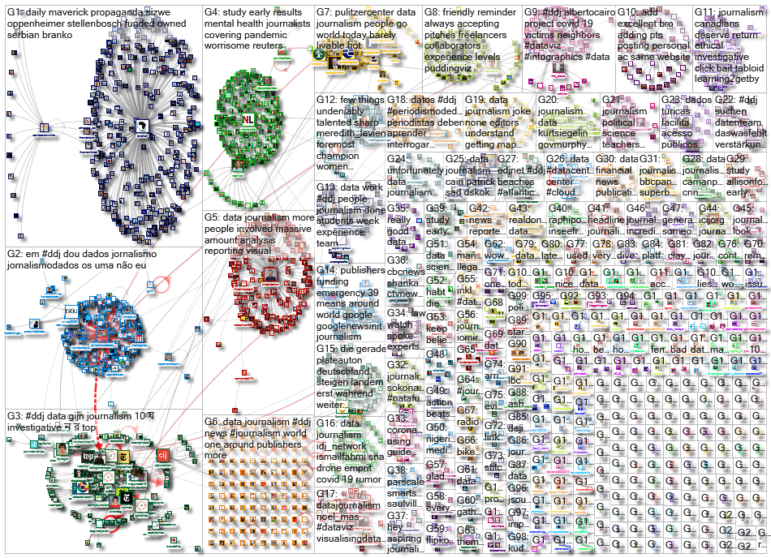In the midst of the pandemic, some newsrooms haven’t forgotten about the growing threat of climate change. Our NodeXL #ddj mapping from July 20 to 26 finds ProPublica partnering with The New York Times Magazine to examine climate migration and where climate refugees are moving to. On the COVID-19 front, FiveThirtyEight revealed disparities in the availability of testing sites between Black and Hispanic neighborhoods and white areas, broadcaster RBB highlighted that the risk of coronavirus was more keenly felt by low-income earners, and the Google News Initiative and Agência Lupa communicated the impact of the pandemic by visually putting readers at the epicenter of an outbreak.
The Great Climate Migration
ProPublica and The New York Times Magazine partnered to examine the issue of climate migration, in a project supported by the Pulitzer Center. In a visual essay in the NYT, they estimate that the barely-livable hot zones in the world will increase from the current 1% to 19% by 2070. Where will the people living in these areas go? The article looks at trends in population shifts. Read about their climate migration model here.
This fascinating story by @AbrahmL puts climate and the whole world and its unique struggles into perspective https://t.co/i8LOZudpJ6 With stunning images by @MeridithKohut and amazing collaboration @propublica, @pulitzercenter pic.twitter.com/DMVrB04pJa
— Karan Deep Singh 🏳️🌈 (@Karan_Singhs) July 25, 2020
Where Will Climate Refugees Go?
While this ProPublica story is the same as the NYT visual essay above, the lead paragraphs and design are different and worth a look. Among the findings: the climate in certain regions will become too hostile for farming and people will lose their ability to farm grains and vegetables. Roughly a billion people will be pushed outside zones in which humans have lived for thousands of years.
A look into a future where more than 30 million migrants fleeing to the US border over the next 30 years due to unpredictable weather patterns. Climate changes will be a major driver of migration. It already is. #ClimateCrisis @RefugeesIntl @HIASrefugees https://t.co/vQSKPlKSy8
— Sonia Nazario (@SLNazario) July 24, 2020
Visualizing an Outbreak Epicenter
Funded by the Google News Initiative, the project No Epicentro (“At the Epicenter”) asks: What if all confirmed COVID-19 victims in Brazil were your neighbors? Published by Agência Lupa, it is available just in Portuguese for now — there’ll be an English version soon —but you can run it through an automated translator, and it’s easy to understand. The data and code are free to download.
New project: What if all COVID-19 victims were your neighbors? https://t.co/8VBFD9y9iz#dataViz #infographics #ddj #dataVisualization #dataJournalism pic.twitter.com/qVm982Wjkn
— Alberto Cairo (@AlbertoCairo) July 24, 2020
Brazil Military’s Conflicts of Interest
By analyzing data in Brazil’s Transparency Portal and cross-referencing with ownership data on Brasil.io, Brazilian news site Metrópoles discovered that the country’s military had signed supply contracts with at least 14 companies owned by soldiers on active duty. In three cases, the companies were providing goods and services to the exact battalions where the owners were serving. These projects received at least 2.6 million reals (about half a million USD) from public coffers. (In Portuguese.)
Ao menos 14 empresas de militares da ativa fecharam negócios com as próprias forças armadas. Em um caso, um oficial abriu restaurante para fornecer comida para o seu batalhão em MT. Apuração de @LucasMarchesini e @raphael_veleda no @Metropoles https://t.co/5UcgD91r4G pic.twitter.com/ajayRSDdi0
— Guilherme Waltenberg (@Gwaltenberg) July 26, 2020
Low Earners Have Higher Coronavirus Risk
Inspired by a piece in The New York Times, broadcaster rbb24 took a look at different work sectors in Germany to see if there was a significant, negative correlation between physical contact and low-paying jobs. Its analysis found that besides healthcare personnel, low earners do have the highest risk of contracting the coronavirus due to higher potential for contact through their jobs, especially in the retail and catering sectors.
So slightly late to do a English version. But:
We made a data driven story showing those with lowest wages have the highest Corona risk.
Also, it is a great example for why I love #OpenData culture in #ddj and science. THREAD 1/Xhttps://t.co/QXZtiED4ea pic.twitter.com/YFtyhiua1D
— Haluka Maier-Borst (@HalukaMB) July 27, 2020
Need a COVID-19 Test? Be Rich and White.
An analysis by FiveThirtyEight found that there were disparities in the availability of COVID-19 testings sites in the United States between predominantly Black and Hispanic neighborhoods — where people are more likely to experience longer wait times and understaffed testing centers — and largely white areas. A similar disparity exists between richer and poorer neighborhoods. Bonus: FiveThirtyEight also did a podcast interview with Dr. Anthony Fauci, the director of the National Institute of Allergy and Infectious Diseases in the US.
This involved a massive amount of data analysis, reporting, visual journalism and more by a ton of very skilled people.
Read it.
It’s important.https://t.co/pWGRSPeLmB
— Micah Cohen (@micahcohen) July 22, 2020
Germany’s Rental Price “Brake”
When Germany introduced a “rent brake” in 2015, which was supposed to stop or at least slow down the rise in rents, the initiative was applauded. But the scheme has had the opposite effect in many places. Data analyses by Panorama, a political show on the German television channel Das Erste, found that rents in many cities are not only far more expensive than legally permitted but that landlords have used a legal loophole relating to “comprehensive modernization,” or renovations, to increase rents.
Wie hoch liegen die Mieten über dem Durchschnittsmitespiegel? Zusammen mit Annette Kammerer und @edeljoe haben wir Wohnungsannoncen analysiert#ddj #pythonhttps://t.co/rYy9MaCQv0
— Claus Hesseling (@the_claus) July 23, 2020
Colombia Data Journalist Claudia Baez
Periodismo de Datos interviewed Colombian data journalist Claudia Báez, co-founder of independent digital media site Cuestión Pública, about data journalism in the region, her work with data, and how Cuestión Pública utilizes data to support investigative journalism. (In Spanish.)
Claudia Báez: "El periodismo de datos se hace al servicio de la ciudadanía" https://t.co/jfIeel8Ozr
Por: @CoceresMaqui @claudibaez #ddj #periodismodedatos
— Periodismo de Datos – UNDAV (@datosundav) July 23, 2020
Pitch Visual Essays to The Pudding
The Pudding, a US-based online publication that explains ideas debated in culture with visual essays, welcomes story pitches every quarter. They pay up to US$5,000 for end-to-end work on a visual essay, and they promise to provide detailed feedback even when it’s not a good fit for them. Read their guidelines here. They are also experimenting with a data-driven newsletter, which you can check out here.
We pay up to $5,000 for end-to-end work on a visual essay. Don't be discouraged if you don't have the time or technical background to build an entire project. We regularly take on collaborations; if you have a great idea, we want to work with you to make it happen. 2/
— The Pudding (@puddingviz) July 23, 2020
Going Beyond Data Journalism
The 2020 International Symposium on Online Journalism (ISOJ) was held online between July 20 to 24. Check out the sessions uploaded on YouTube. Among them: a workshop with data journalist Cathleen Crowley and health reporter Verah Okeyo, who shared a toolkit for data journalism projects, and did a demonstration on using the business analytics service Power BI for analyzing and visualizing data. There’s a recap of the first day of the conference here.
O #isoj2020 é um dos eventos mais importantes do jornalismo. Acontece todos os anos em Austin – ou seja, é para poucos
Esse ano a edição é online. E grátis. E é emocionante ver tanta gente boa assistindo junto. Parabéns e obrigado, @Rosental e @ISOJ2020 https://t.co/6dekeLgNlL
— Fabrício Vitorino (@Fabyuri) July 20, 2020
Thanks again to Marc Smith of Connected Action for gathering the links and graphing them. The Top Ten #ddj list is curated weekly.
 Eunice Au is GIJN’s program coordinator. Previously, she was a Malaysia correspondent for Singapore’s The Straits Times, and a journalist at the New Straits Times. She has also written for The Sun, Malaysian Today, and Madam Chair.
Eunice Au is GIJN’s program coordinator. Previously, she was a Malaysia correspondent for Singapore’s The Straits Times, and a journalist at the New Straits Times. She has also written for The Sun, Malaysian Today, and Madam Chair.

